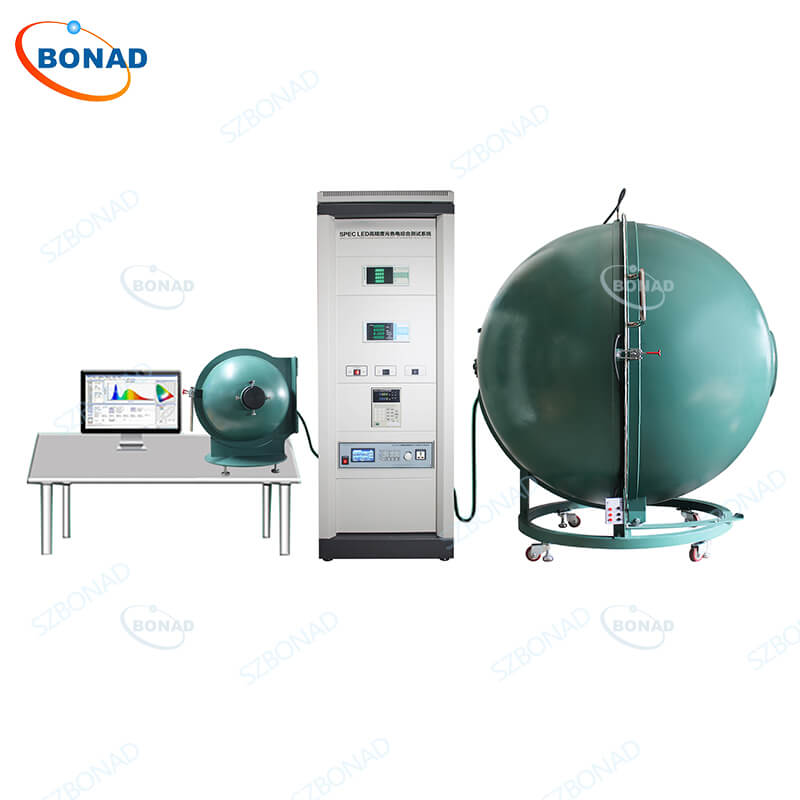Introduction:
An integrating sphere, also referred to as a photometric sphere or luminous sphere, is a hollow spherical device used for various optical measurements. Its design features one or more ports on the sphere’s surface for light input and placement of light-receiving devices.
Structure and Characteristics of Integrating Spheres:
Sphere Shell and Deviation Standards:
• An integrating sphere is constructed with a complete spherical shell, ensuring the inner surface maintains an ideal spherical shape.
• Deviation from the perfect spherical surface should not exceed 0.2% of the inner diameter to maintain accuracy.
Inner Surface Coating Material:
• The inner surface is coated with a highly diffuse reflecting material to ensure multiple reflections, resulting in uniform illumination.
• Common materials include magnesium oxide (MgO) and barium sulfate (BaSO₄), which are mixed with a resin binder and sprayed onto the inner surface.
• Magnesium oxide coatings typically have a spectral reflectance exceeding 99% within the visible spectrum.
Aperture Ratio:
• To enhance measurement accuracy, the aperture ratio of the integrating sphere should be minimized.
• The aperture ratio is defined as the ratio of the port area to the total inner surface area of the sphere.
Applications of Integrating Spheres:
Integrating spheres are widely used in optical measurements, including:
• Light source measurements: They can accurately measure total luminous flux by uniformizing light intensity.
• Measurement of optical properties of materials: They are used to measure reflectance and transmittance.
• Photometry measurements: They provide a uniform illumination environment for measuring luminous distribution.

Steps for Measurement Using an Integrating Sphere Spectral Analysis System:
Measurement Steps:
Standard Lamp Measurement:
• Place a standard lamp inside the integrating sphere and illuminate it.
• Record spectral data from the standard lamp as a reference.
Sample Measurement:
• Replace the standard lamp with the sample to be tested and illuminate it.
• Record spectral data from the sample lamp.
Self-absorption Correction:
Perform self-absorption correction on measurement data to eliminate absorption effects from the sample’s emitted light.
Self-absorption Effect and Its Impact:
During measurements, particularly for LED products, components like lamp bodies or heat sinks may absorb light. This self-absorption effect can lead to measurement errors due to changes in response constants when sample size or shape differs from that of the standard lamp. Additionally, spectral reflectance differences at various wavelengths can result in varying self-absorption effects.
Methods to Eliminate Self-absorption Effect:
To mitigate this effect, auxiliary lamps with broadband spectral emission (e.g., halogen bulbs) can be used. These lamps should provide uniform illumination inside the integrating sphere to correct errors caused by self-absorption effectively.
Conclusion:
By adhering to these steps and methods, measurement accuracy using integrating sphere spectral analysis systems can be significantly improved. This reduces the impact of self-absorption effects on results and ensures accurate spectral data acquisition.
Maintenance of Integrating Spheres:
Proper use and regular maintenance can extend an integrating sphere’s service life significantly. Maintenance includes coating care, circuit maintenance, and fixture upkeep.
Coating Maintenance:
• Cleaning method: Due to its uneven chemical coating, fine dust can easily adhere inside an integrating sphere. Gently wipe with a soft brush in one direction during cleaning.
Operating precautions:
• Handle bulbs carefully before testing to avoid dropping or touching the coating.
• After testing, turn off power immediately, remove fixtures promptly, and close the integrating sphere to prevent dust entry.
Circuit Maintenance:
• Grounding and power selection: Ensure proper grounding and choose appropriate power supplies for safe operation.
• Regular inspection: Check external wires and terminal junction boxes regularly for damage; repair or replace as needed.
Fixture Maintenance:
• Lamp head contacts: Ensure contacts are undamaged for stable power supply.
• Wiring check: Confirm correct wiring connections to avoid loose or incorrect setups that could affect test results.


